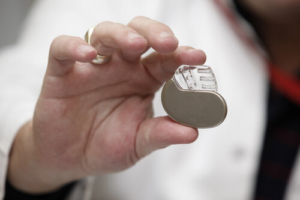Read more about cardioversion vs ablation in this post. Imagine living with a heart condition that causes an irregular heartbeat, affecting your daily life. Atrial fibrillation (AFib) is one such condition, and it requires proper treatment to manage symptoms and reduce the risk of stroke.
Two common non-pharmacological treatments for AFib are cardioversion and ablation. But how do you choose the best treatment option for your specific situation? In this blog post, we’ll explore the differences between cardioversion and ablation procedures, understand risks, and what to expect after each treatment.
Key Takeaways
Cardioversion and ablation are two non-pharmacological treatments used to correct heart rhythm irregularities, such as atrial fibrillation.
The procedure specifics, risks/complications, and post-treatment expectations of each should be discussed with a healthcare provider prior to making an informed decision.
Patients can expect improved quality of life following either treatment depending on their individual circumstances.
Understanding Cardioversion: A Quick Overview

Cardioversion involves the use of electric shocks to restore the heart’s natural rhythm. It is typically performed using paddles or patches and is commonly used for treating an irregular or rapid heartbeat, such as, atrial fibrillation.
The primary goal of cardioversion is to quickly normalize the heart rhythm by resetting it with electrical shocks, ultimately aiming to restore the heart’s natural rhythm and ensure optimal cardiovascular function.
In general, a cardioversion is usually a quick and well tolerated procedure. Electrical cardioversion is often successful in restoring a regular heart rhythm in the short term, but it is possible for atrial fibrillation, especially persistent atrial fibrillation, to recur after the procedure. Frequently medications are needed to prevent a recurrence of atrial fibrillation after a cardioversion.
Read more details about a cardioversion procedure here.
Delving into Ablation: The Basics

Catheter Ablation, or atrial fibrillation ablation, is another treatment option for atrial fibrillation. It is a minimally invasive procedure that works by creating strategic scars in the heart, including the area around the pulmonary veins, to block abnormal electrical signals, employing radiofrequency energy or cryoablation.
Atrial fibrillation ablation is typically performed by inserting catheters (thin hollow tubes) into a blood vessel in the groin and advancing it up to the heart, which provides access to the inside of the heart and the pulmonary veins.
Your doctor may suggest catheter ablation if the patient has not responded to medication or other treatments, or recurrent atrial fibrillation after a cardioversion.
In general, the earlier someone undergoes an ablation procedure for atrial fibrillation, the better the success rate of the procedure. Patients in earlier stages of AFib, called Paroxysmal AFib (where AFib comes and goes, not in AFib all the time) usually have the best success rate with an ablation procedure. Recent literature has also suggested that patients who undergo an AFib ablation procedure within the first year after diagnosis have the best results.
Read more details about atrial fibrillation ablation procedure here.
Cardioversion vs Ablation: When to Choose Which
When deciding between cardioversion and ablation, several factors should be taken into consideration, such as:
The duration of atrial fibrillation
The age of the patient
The functional class of the patient
The response to previous treatments
Additional health conditions of the patient
Cardioversion is commonly recommended for patients with newly developed persistent atrial fibrillation, whereas ablation is usually suggested for those with longer duration of symptoms or an inadequate response to medication, or a failed cardioversion attempt.
A cardioversion may also be a good strategy for patients who have persistent atrial fibrillation, whom are looking to restore normal rhythm, but may be too sick or have several additional health conditions that would increase risk for a catheter ablation.
The acute success rates of cardioversion in managing atrial fibrillation can be over 90% in my experience. However, recurrences after a cardioversion are common and strategies are needed to minimize risk of recurrent atrial fibrillation.
In contrast, the success rates of ablation in managing atrial fibrillation range from 57% to 78%. However, in general, it provides better long term control when compared to a cardioversion. It’s important to discuss these success rates and your individual situation with your healthcare provider to determine the best course of action for your specific case.
Procedure Specifics: Cardioversion ->

Having covered the basic details of both procedures, we will now detail cardioversion. This includes pre-procedure preparations, the process of administering electric shock, and post-procedure care.
Pre-Procedure Considerations
Before the cardioversion procedure, certain preparations must be made. Tests for blood clots, such as transesophageal echocardiography (TEE), are frequently performed to assess the presence of blood clots. Patients are also advised to follow their healthcare provider’s instructions regarding fasting, which typically involves abstaining from food or beverages for several hours before the procedure.
Blood thinners might be used prior to and following cardioversion to avert blood clots. Patients must adhere to these guidelines to ensure the safety and success of the cardioversion procedure.
During the Shock
During the cardioversion procedure, anesthesia is usually utilized to ensure that the patient does not feel pain. These medications are usually administered by an anesthesiologist. Patient’s vital signs, including oxygen levels are lcolsey monitored during the administration of these medications.
The synchronized electrical shock, administered through direct current (DC) shocks, is delivered to the heart using a specialized machine and electrodes to re-establish a normal heart rhythm. The shock typically lasts only a few seconds.
Post-Procedure Care
After the cardioversion procedure, patients should adhere to the instructions provided by their healthcare provider regarding post-procedure care. This may involve taking medications, abstaining from strenuous activities, and attending follow-up appointments.
Patients are typically monitored for at least an hour or more following the procedure, ensuring that their heart has returned to a normal rhythm and detecting any potential complications from the procedure or sedation. It is important to remain at the healthcare provider’s facility until fully awake before departing.
Procedure Specifics: Atrial Fibrillation Ablation

We will now detail the specifics of ablation, entailing pre-ablation preparations, the process of intentional and strategic scarring the heart, and recovery and follow-up care.
Preparing for Ablation
Preparing for ablation involves the following steps:
Discussing risks with a healthcare provider
Undergoing tests to gain further insight into the patient’s cardiac condition
Following medication instructions provided by the healthcare provider
Refraining from eating or drinking anything after midnight on the day of the procedure
The Ablation Process
The ablation process involves the following steps:
Insertion of catheters from the femoral veins in the groin into the heart
Utilization of electrical mapping to identify areas of concern
Application of radiofrequency energy or cryoablation to create scars
Catheters are utilized to deliver energy to target and destroy a specific area of heart tissue, thereby correcting abnormal heart rhythms in the ablation process and affecting blood vessels in the targeted area.
Electrical mapping is a process wherein physicians utilize an electrically sensitive catheter to map the sources of “extra” electrical activity throughout the heart. This data helps guide the treatment process, such as cardiac ablation, to rectify the issue.
During the ablation procedure, radiofrequency energy or cryotherapy are transmitted through a precisely placed catheter to target and eliminate the specific tissue causing atrial fibrillation.
Read more details about a catheter ablation procedure here.
Recovery and Follow-Up
Following the ablation procedure, the patient is transferred to a recovery area where they are closely monitored for their vital signs, such as heartbeat and blood pressure, to ensure no complications arise. Patients should adhere to all instructions provided by their healthcare provider with regard to:
Medications, including blood thinners
Exercise
Diet
Wound care
Additionally, they should attend all scheduled follow-up appointments.
The recovery period for an ablation procedure typically lasts a few days up to one week. Attending timely follow-up appointments within the first several months after the procedure can help evaluate arrhythmia recurrences and monitor the patient’s condition.
Risks and Complications: A Side-by-Side Comparison

When weighing the two procedures, one must consider potential risks and complications.
Atrial fibrillation ablation carries potential risks, such as bleeding, perforation, shortness of breath, stroke, esophageal fistula formation, and the recurrence of atrial fibrillation.
Meanwhile, cardioversion carries its own risks, including the potential for blood clots and the need for blood thinners. It is important to discuss these risks with your healthcare provider to determine the best treatment option for your specific situation.
Cardioversion vs Ablation: What I Choose With My Patients

In general, the cardioversion procedure is a quicker and safer procedure then an atrial fibrillation ablation procedure. For my patients that are too frail for an invasive procedure such as an atrial fibrillation ablation procedure. In addition, I also frequently perform a cardioversion in patients with persistent atrial fibrillation prior to catheter ablation procedure, in an effort to optimize symptoms prior to a more invasive procedure. When an ablation is performed in sinus rhythm, it is usually a faster and less risker procedure, resulting in a faster recovery from the procedure itself.
However, when it comes to long-term control, a catheter ablation procedure results in much better long-term success, with less recurrences of atrial fibrillation when compared to a cardioversion. In addition, patients with frequently require less long-term medications after a catheter ablation vs a cardioversion procedure. In general, a catheter ablation procedure is my preferred treatment option for appropriate patients who struggle with symptoms despite multiple medications or have recurrent atrial fibrillation after a cardioversion procedure.
Life After Treatment: What Patients Can Expect
Patients can anticipate improvements in quality of life after undergoing catheter ablation or cardioversion. Studies have indicated that these treatments can lead to a reduction in atrial fibrillation burden, improved arrhythmia control, and a decrease in AF recurrences, ultimately resulting in an overall improvement in symptoms and an enhanced quality of life for patients.
The prognosis after catheter ablation or cardioversion varies depending on the individual patient and the condition being treated. After ablation or cardioversion:
Ongoing medication may not be required to control heart rhythm in some cases.
In some cases, blood thinners may be recommended following catheter ablation or cardioversion for AFib treatment, depending on a patient’s overall stroke risk.
Regular check-ups are essential for monitoring the patient’s condition and ensuring that the treatment has been effective and to prevent recurrences of atrial fibrillation.
Navigating Your Options with a Health Care Professional

Selecting the optimal treatment for heart rhythm correction requires open communication with your healthcare professional. It’s important to discuss your individual circumstances, potential risks, and benefits with your physician to make the best decision about your treatment options and receive the best care possible.
To communicate effectively with your healthcare professional, follow these tips:
Be prepared with a list of questions and concerns
Be honest about your symptoms and medical history
Ask for clarification if you don’t understand something
Seek reliable information from reputable sources
Remember to be an active participant in your healthcare decisions and advocate for yourself.
Summary
In conclusion, choosing the right treatment for heart rhythm correction is a crucial decision that requires thorough understanding and discussion with a healthcare professional. Both cardioversion and ablation offer effective solutions for managing atrial fibrillation, but each has its own set of risks and benefits. It’s essential to carefully consider your specific situation, weigh the risks and potential outcomes, and collaborate closely with your healthcare provider to choose the best course of action for your heart health.
Frequently Asked Questions
Which is safer ablation or cardioversion?
Overall, cardioverson is a safer and faster procedure when compared to an atrial fibrillation ablation procedure. It is usually the treatment of choice for patients with unstable symptoms or significant additional health conditions.
What is the disadvantage of cardioversion?
Cardioversion carries some risks, such as the potential for stroke or dangerous abnormal heartbeat, and may not always restore normal heart rhythm. Additionally, it can cause dislodged blood clots or potentially provoke a new and serious arrhythmia to develop, as a results, blood thinners are usually required before and after a cardioversion.
When is cardioversion not recommended?
Cardioversion is not recommended if you have minor symptoms, are elderly, have had AFib a long time, or have other major medical problems. Alternative treatments like heart rate control with medicines might be more suitable. In addition, a cardioversion is not recommended in patients with paroxysmal AFib, where AFib stops on its own, usually within 48 hours.
What is the next step after cardioversion?
After cardioversion, you may be put on an antiarrhythmic drug and anticoagulant to prevent blood clots and to prevent recurrences of AFib. Speak to your doctor about what exercises can be safely done after the procedure, gradually building up activity levels as directed. Additionally, you will need to take blood-thinning medications for at least several weeks.
What’s next if cardioversion doesn’t work?
If cardioversion doesn’t successfully restore your normal heart rhythm or if the irregular rhythm returns, your healthcare provider may suggest other treatment options. These can include medications, lifestyle changes, or more invasive procedures like atrial fibrillation ablation. It’s important to discuss these potential next steps with your healthcare provider to understand the benefits and risks of each treatment option. Always remember that treatment plans should be individualized to your specific condition and overall health.
The Best Atrial Fibrillation Book
Your Complete Guide To AFib: The Essential Manual For Every Patient With Atrial Fibrillation
$15.95 (as of April 27, 2024 10:32 GMT -06:00 - More infoProduct prices and availability are accurate as of the date/time indicated and are subject to change. Any price and availability information displayed on [relevant Amazon Site(s), as applicable] at the time of purchase will apply to the purchase of this product.) The A to Z guide on everything you need to know about atrial fibrillation. Written by AFib expert Dr. Percy Morales MD. Over 120 pages of essential information on medications, procedures, and lifestyles modifications for AFib. Easy to read for every patient.
Shop AFib Products on Amazon
KardiaMobile 6-Lead Personal EKG Monitor – Six Views of The Heart – Detects AFib and Irregular Arrhythmias – Instant Results in 30 Seconds – Works with Most Smartphones - FSA/HSA Eligible

KardiaMobile 1-Lead Personal EKG Monitor – Record EKGs at Home – Detects AFib and Irregular Arrhythmias – Instant Results in 30 Seconds – Easy to Use – Works with Most Smartphones - FSA/HSA Eligible

Apple Watch Series 9 [GPS 41mm] Smartwatch with Storm Blue Aluminum Case with Silver Sport Band M/L. Fitness Tracker, Blood Oxygen & ECG Apps, Always-On Retina Display

Fitbit Sense 2 Advanced Health and Fitness Smartwatch with Tools to Manage Stress and Sleep, ECG App, SpO2, 24/7 Heart Rate and GPS, Shadow Grey/Graphite, One Size (S & L Bands Included)

OMRON - Complete Wireless Upper Arm Blood Pressure Monitor + EKG - Built-in Bluetooth Technology

Omron Hem 7361T Bluetooth Digital Blood Pressure Monitor with Afib Indicator and 360° Accuracy Intelliwrap Cuff for Most Accurate Measurements (White)

EMAY Portable ECG Monitor | Record ECG and Heart Rate Anytime Anywhere | Stand-Alone Device with LCD Screen and Storage | No Subscription Required

Samsung Galaxy Watch 6 44mm Smartwatch with HR Zones, Sleep Coaching, Heart Monitor - Graphite

Natural Rhythm Triple Calm Magnesium 150 mg - 120 Capsules – Magnesium Complex Compound Supplement with Magnesium Glycinate, Malate, and Taurate. Calming Blend for Promoting Rest and Relaxation.

Pure Encapsulations Magnesium (Glycinate) - Supplement to Support Stress Relief, Sleep, Heart Health, Nerves, Muscles, and Metabolism* - with Magnesium Glycinate - 180 Capsules

















![Apple Watch Series 9 [GPS 41mm] Smartwatch with Storm Blue Aluminum Case with Silver Sport Band M/L. Fitness Tracker, Blood Oxygen & ECG Apps, Always-On Retina Display #1](https://m.media-amazon.com/images/I/311xwtp4mFL._SL100_.jpg)
![Apple Watch Series 9 [GPS 41mm] Smartwatch with Storm Blue Aluminum Case with Silver Sport Band M/L. Fitness Tracker, Blood Oxygen & ECG Apps, Always-On Retina Display #2](https://m.media-amazon.com/images/I/41j+8AaUGsL._SL100_.jpg)
![Apple Watch Series 9 [GPS 41mm] Smartwatch with Storm Blue Aluminum Case with Silver Sport Band M/L. Fitness Tracker, Blood Oxygen & ECG Apps, Always-On Retina Display #3](https://m.media-amazon.com/images/I/41jIyxZitnL._SL100_.jpg)
![Apple Watch Series 9 [GPS 41mm] Smartwatch with Storm Blue Aluminum Case with Silver Sport Band M/L. Fitness Tracker, Blood Oxygen & ECG Apps, Always-On Retina Display #4](https://m.media-amazon.com/images/I/41IpNJERjCL._SL100_.jpg)
![Apple Watch Series 9 [GPS 41mm] Smartwatch with Storm Blue Aluminum Case with Silver Sport Band M/L. Fitness Tracker, Blood Oxygen & ECG Apps, Always-On Retina Display #5](https://m.media-amazon.com/images/I/31o17yhfYpL._SL100_.jpg)

















































